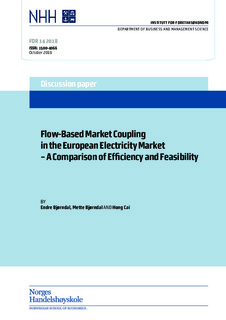| dc.description.abstract | In May 2015, the Flow-Based Market Coupling (FBMC) model replaced the Available Transfer Capacity (ATC) model in Central Western Europe to determine the power transfers between countries or price areas. The FBMC model aims to enhance market integration and to better monitor the physical power flows. The FBMC model is expected to lead to increased social welfare in the day-ahead market and more frequent price convergence between different market areas. This paper gives a discussion of the procedures of market clearing and a mathematical formulation of the FBMC model. Moreover, we discuss the relationships between the nodal pricing, ATC, and FBMC models. In addition to an illustrative 3-node example, we examine the FBMC model in two test systems and show the difficulties in implementing the model in practice. We find that a higher social surplus in the day-ahead market may come at the cost of more re-dispatching in real time. We also find that the FBMC model might fail to relieve network congestion and better utilize the power resources, even when compared to the ATC model. | nb_NO |
